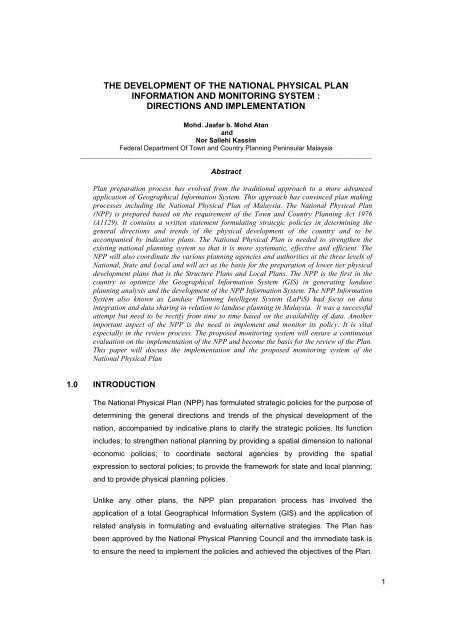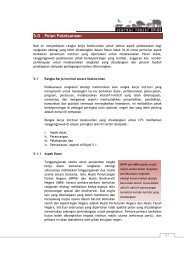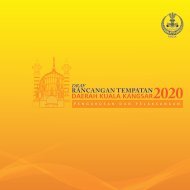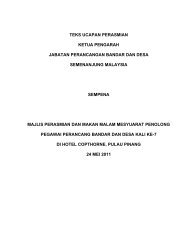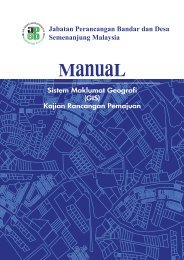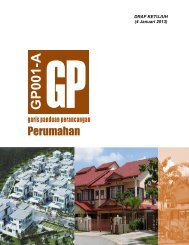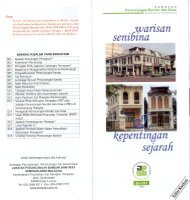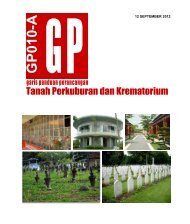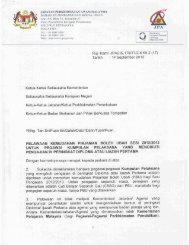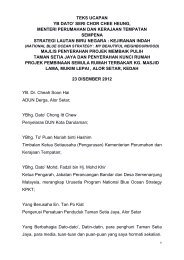the development of the national physical plan information and ...
the development of the national physical plan information and ...
the development of the national physical plan information and ...
Create successful ePaper yourself
Turn your PDF publications into a flip-book with our unique Google optimized e-Paper software.
THE DEVELOPMENT OF THE NATIONAL PHYSICAL PLAN<br />
INFORMATION AND MONITORING SYSTEM :<br />
DIRECTIONS AND IMPLEMENTATION<br />
Mohd. Jaafar b. Mohd Atan<br />
<strong>and</strong><br />
Nor Sallehi Kassim<br />
Federal Department Of Town <strong>and</strong> Country Planning Peninsular Malaysia<br />
_______________________________________________________________________________<br />
Abstract<br />
Plan preparation process has evolved from <strong>the</strong> traditional approach to a more advanced<br />
application <strong>of</strong> Geographical Information System. This approach has convinced <strong>plan</strong> making<br />
processes including <strong>the</strong> National Physical Plan <strong>of</strong> Malaysia. The National Physical Plan<br />
(NPP) is prepared based on <strong>the</strong> requirement <strong>of</strong> <strong>the</strong> Town <strong>and</strong> Country Planning Act 1976<br />
(A1129). It contains a written statement formulating strategic policies in determining <strong>the</strong><br />
general directions <strong>and</strong> trends <strong>of</strong> <strong>the</strong> <strong>physical</strong> <strong>development</strong> <strong>of</strong> <strong>the</strong> country <strong>and</strong> to be<br />
accompanied by indicative <strong>plan</strong>s. The National Physical Plan is needed to streng<strong>the</strong>n <strong>the</strong><br />
existing <strong>national</strong> <strong>plan</strong>ning system so that it is more systematic, effective <strong>and</strong> efficient. The<br />
NPP will also coordinate <strong>the</strong> various <strong>plan</strong>ning agencies <strong>and</strong> authorities at <strong>the</strong> three levels <strong>of</strong><br />
National, State <strong>and</strong> Local <strong>and</strong> will act as <strong>the</strong> basis for <strong>the</strong> preparation <strong>of</strong> lower tier <strong>physical</strong><br />
<strong>development</strong> <strong>plan</strong>s that is <strong>the</strong> Structure Plans <strong>and</strong> Local Plans. The NPP is <strong>the</strong> first in <strong>the</strong><br />
country to optimize <strong>the</strong> Geographical Information System (GIS) in generating l<strong>and</strong>use<br />
<strong>plan</strong>ning analysis <strong>and</strong> <strong>the</strong> <strong>development</strong> <strong>of</strong> <strong>the</strong> NPP Information System. The NPP Information<br />
System also known as L<strong>and</strong>use Planning Intelligent System (LaPiS) had focus on data<br />
integration <strong>and</strong> data sharing in relation to l<strong>and</strong>use <strong>plan</strong>ning in Malaysia. It was a successful<br />
attempt but need to be rectify from time to time based on <strong>the</strong> availability <strong>of</strong> data. Ano<strong>the</strong>r<br />
important aspect <strong>of</strong> <strong>the</strong> NPP is <strong>the</strong> need to implement <strong>and</strong> monitor its policy. It is vital<br />
especially in <strong>the</strong> review process. The proposed monitoring system will ensure a continuous<br />
evaluation on <strong>the</strong> implementation <strong>of</strong> <strong>the</strong> NPP <strong>and</strong> become <strong>the</strong> basis for <strong>the</strong> review <strong>of</strong> <strong>the</strong> Plan.<br />
This paper will discuss <strong>the</strong> implementation <strong>and</strong> <strong>the</strong> proposed monitoring system <strong>of</strong> <strong>the</strong><br />
National Physical Plan<br />
1.0 INTRODUCTION<br />
The National Physical Plan (NPP) has formulated strategic policies for <strong>the</strong> purpose <strong>of</strong><br />
determining <strong>the</strong> general directions <strong>and</strong> trends <strong>of</strong> <strong>the</strong> <strong>physical</strong> <strong>development</strong> <strong>of</strong> <strong>the</strong><br />
nation, accompanied by indicative <strong>plan</strong>s to clarify <strong>the</strong> strategic policies. Its function<br />
includes; to streng<strong>the</strong>n <strong>national</strong> <strong>plan</strong>ning by providing a spatial dimension to <strong>national</strong><br />
economic policies; to coordinate sectoral agencies by providing <strong>the</strong> spatial<br />
expression to sectoral policies; to provide <strong>the</strong> framework for state <strong>and</strong> local <strong>plan</strong>ning;<br />
<strong>and</strong> to provide <strong>physical</strong> <strong>plan</strong>ning policies.<br />
Unlike any o<strong>the</strong>r <strong>plan</strong>s, <strong>the</strong> NPP <strong>plan</strong> preparation process has involved <strong>the</strong><br />
application <strong>of</strong> a total Geographical Information System (GIS) <strong>and</strong> <strong>the</strong> application <strong>of</strong><br />
related analysis in formulating <strong>and</strong> evaluating alternative strategies. The Plan has<br />
been approved by <strong>the</strong> National Physical Planning Council <strong>and</strong> <strong>the</strong> immediate task is<br />
to ensure <strong>the</strong> need to implement <strong>the</strong> policies <strong>and</strong> achieved <strong>the</strong> objectives <strong>of</strong> <strong>the</strong> Plan.<br />
1
In relation to this, <strong>the</strong> implementation <strong>of</strong> <strong>the</strong> <strong>information</strong> system <strong>and</strong> monitoring<br />
process is considered as an important aspects in manipulating <strong>and</strong> analysis <strong>of</strong> <strong>the</strong><br />
Plan which provide <strong>the</strong> inputs in <strong>the</strong> review <strong>of</strong> <strong>the</strong> NPP.<br />
2.0 NATIONAL DEVELOPMENT PLANNING<br />
The three levels <strong>of</strong> <strong>the</strong> <strong>national</strong> <strong>development</strong> <strong>plan</strong>ning framework has stated <strong>the</strong><br />
three tier <strong>of</strong> <strong>plan</strong>s which constitutes <strong>the</strong> <strong>national</strong>, regional/states <strong>and</strong> local <strong>plan</strong>ning<br />
(Figure 1). Every level are integrated <strong>and</strong> operated as a collectively cohesive system<br />
with <strong>the</strong> same goal in supporting <strong>and</strong> to achieve <strong>the</strong> Vision 2020. Based on <strong>the</strong>se <strong>the</strong><br />
implementation <strong>of</strong> <strong>development</strong> <strong>plan</strong>ning <strong>plan</strong>s has features <strong>the</strong> three levels which by<br />
nature are integrated <strong>and</strong> dependent on each o<strong>the</strong>r. The integration needs<br />
st<strong>and</strong>ardization <strong>and</strong> to achieve this, action has been taken in coordinating <strong>the</strong> base<br />
map, l<strong>and</strong>use classifications, coding system <strong>and</strong> terminology. While most <strong>of</strong> <strong>the</strong><br />
st<strong>and</strong>ardization has centred on data formatting <strong>and</strong> l<strong>and</strong>use classifications, <strong>the</strong><br />
analytical part <strong>of</strong> <strong>the</strong> <strong>plan</strong> making processes is also linked due respect to <strong>the</strong> detailing<br />
<strong>of</strong> each <strong>plan</strong>s.<br />
National Physical Plan<br />
The Town <strong>and</strong> Country Planning Act 1976 (A1129) has stated that <strong>the</strong> Director<br />
General <strong>of</strong> Town <strong>and</strong> Country Planning shall upon <strong>the</strong> directive <strong>of</strong> <strong>the</strong> Council<br />
prepare <strong>and</strong> submit to <strong>the</strong> Council for its approval a draft National Physical Plan<br />
which cover Peninsular Malaysia. Once <strong>the</strong> Plan is approved <strong>the</strong> policies <strong>of</strong> <strong>the</strong> NPP<br />
will take effect unless <strong>the</strong>y are subsequently altered or replaced. In view <strong>of</strong> changing<br />
socio-economic circumstances <strong>of</strong> <strong>the</strong> country, <strong>the</strong> Act stipulates that <strong>the</strong> Plan be<br />
reviewed every five years in t<strong>and</strong>em with <strong>the</strong> review <strong>of</strong> <strong>the</strong> National Five Year<br />
Development Plans, or as <strong>and</strong> when directed by <strong>the</strong> Council.<br />
2
Figure 1:<br />
National Development Planning Framework.<br />
VISION 2020<br />
LEVEL 1 : NATIONAL PLANNING<br />
5 - YEAR<br />
DEVELOPMENT<br />
PLAN<br />
NATIONAL<br />
PHYSICAL<br />
PLAN<br />
SECTORAL<br />
POLICIES/<br />
PLANS<br />
LEVEL 2 : REGIONAL / STATE PLANNING<br />
5 - YEAR<br />
DEVELOPMENT<br />
PLAN<br />
REGIONAL /<br />
STRUCTURE<br />
PLAN<br />
SECTORAL<br />
POLICIES/<br />
PLANS<br />
LEVEL 3 : LOCAL PLANNING<br />
LOCAL<br />
PLAN<br />
SPECIAL AREA<br />
PLAN<br />
Structure Plans<br />
Structure Plans<br />
Structure Plans formulated <strong>the</strong> expectations <strong>of</strong> <strong>development</strong> within each state <strong>and</strong><br />
propose major economic <strong>and</strong> infrastructure projects for <strong>the</strong> states.<br />
Local Plans<br />
Local Plans provides <strong>the</strong> vehicles for <strong>development</strong> control process <strong>and</strong> setting <strong>the</strong><br />
direction <strong>of</strong> <strong>development</strong> for a local <strong>plan</strong>ning authority area.<br />
3
3.0 NATIONAL PHYSICAL PLAN PREPARATION PROCESS<br />
The study involves 7 major sectors consisting <strong>of</strong> Global Framework <strong>and</strong> Macro<br />
Economics, Physical Planning <strong>and</strong> Urbanisation, Population, Housing <strong>and</strong> Social<br />
Amenities, Infrastructure <strong>and</strong> Utilities <strong>and</strong> Transport, Environment <strong>and</strong> Natural<br />
Resources, Institutional <strong>and</strong> Implementation.<br />
The overall approach <strong>of</strong> <strong>the</strong> study involves <strong>the</strong> formulation <strong>of</strong> Vision <strong>and</strong> Principles<br />
<strong>and</strong> definition <strong>of</strong> goals <strong>and</strong> objectives (Figure 2). The Vision <strong>and</strong> o<strong>the</strong>r <strong>development</strong><br />
<strong>plan</strong> policies has been accounted for in directing <strong>the</strong> vision <strong>and</strong> goals <strong>of</strong> <strong>the</strong> NPP.<br />
This follows by activities related to compilation <strong>of</strong> database which ranges from all <strong>the</strong><br />
sectoral studies involved.<br />
The collection <strong>and</strong> compilation <strong>of</strong> <strong>the</strong> data base are done sectorally but have been<br />
Figure 2 :<br />
NPP Plan Preparation Process<br />
NPP Information System<br />
National Vision &<br />
National<br />
Development<br />
Policy<br />
Literature<br />
Review <strong>and</strong><br />
Collection <strong>of</strong><br />
Data <strong>and</strong><br />
Information<br />
Analysis <strong>of</strong><br />
Issues &<br />
Problems <strong>and</strong><br />
Opportunities<br />
Evaluation<br />
Vision<br />
Global <strong>and</strong><br />
Regional Trend<br />
Objectives<br />
<strong>and</strong> Principles<br />
Future<br />
Trends <strong>and</strong><br />
Assumptions<br />
Alternative<br />
Development<br />
Strategies<br />
National Physical<br />
Development Strategy<br />
National Physical Plan :<br />
•<br />
Projections<br />
National Physical<br />
Development Indicative<br />
Map 2020<br />
• Written Statement<br />
consists <strong>of</strong> :<br />
- Policies <strong>and</strong> Strategies<br />
- Mechanism for<br />
Implementation,<br />
Management <strong>and</strong><br />
Monitoring <strong>of</strong> NPP<br />
- Manual for National<br />
Data Base<br />
Review<br />
reviewed <strong>and</strong> examined cross sectorally which later formed <strong>the</strong> base for formulating<br />
<strong>the</strong> NPP Information System. Data were monitored <strong>and</strong> updated accordingly <strong>and</strong> will<br />
act as <strong>the</strong> integral part in <strong>the</strong> monitoring <strong>and</strong> updating <strong>of</strong> ‘future’ NPP studies. These<br />
datas will <strong>the</strong>n been analysed where issues, problems <strong>and</strong> opportunities has been<br />
highlighted in <strong>the</strong> process <strong>of</strong> formulating <strong>the</strong> <strong>development</strong> strategy. The process<br />
continues with <strong>the</strong> evaluation <strong>of</strong> <strong>the</strong> <strong>development</strong> strategies before a final Draft NPP<br />
is formulated.<br />
4
The output <strong>of</strong> <strong>the</strong> NPP consists <strong>of</strong> <strong>the</strong> National Physical Framework Indicative Map<br />
<strong>and</strong> Written Statements which consists <strong>of</strong> policies, mechanism for implementation,<br />
<strong>the</strong> <strong>plan</strong>ning <strong>information</strong> system <strong>and</strong> <strong>the</strong> monitoring system <strong>of</strong> <strong>the</strong> NPP. There are 36<br />
policies formulated supported by 194 measures.<br />
The overall approach has indicated <strong>the</strong> <strong>plan</strong> preparation process <strong>of</strong> <strong>the</strong> NPP which<br />
involves from setting <strong>the</strong> goals <strong>and</strong> objectives follows by data collection <strong>and</strong><br />
formulation <strong>of</strong> <strong>development</strong> strategy. Since it is a GIS base study it has achieved in<br />
integrating all relevant data related to spatial distributions <strong>and</strong> <strong>of</strong> course it has assist<br />
significantly in designing <strong>and</strong> modelling data analysis <strong>and</strong> o<strong>the</strong>r related spatial<br />
analysis including <strong>the</strong> formulation <strong>of</strong> <strong>the</strong> National Physical Plan Information System.<br />
4.0 NATIONAL PHYSICAL PLAN INFORMATION SYSTEM<br />
The NPP <strong>information</strong> system was developed to provide functionality in l<strong>and</strong>use<br />
<strong>plan</strong>ning <strong>and</strong> analysis, including <strong>the</strong> followings:<br />
• A mechanism for <strong>the</strong> storage, retrieval <strong>and</strong> manipulation <strong>of</strong> l<strong>and</strong>use <strong>and</strong><br />
related <strong>plan</strong>ning <strong>information</strong> system<br />
• It provides general guideline in <strong>the</strong> <strong>development</strong> <strong>of</strong> an integrated l<strong>and</strong>use<br />
<strong>plan</strong>ning <strong>information</strong> system<br />
• Enable <strong>information</strong> retrieval <strong>and</strong> sharing<br />
The NPP Information System (NPPIS) consists <strong>of</strong> databases grouped into <strong>physical</strong><br />
component, population <strong>and</strong> demographic component, <strong>the</strong> socio-economic component<br />
<strong>and</strong> l<strong>and</strong>use component. Besides <strong>the</strong> four major components it also consists <strong>of</strong><br />
<strong>information</strong> on policies, guidelines <strong>and</strong> <strong>plan</strong>ning statutes which could support<br />
decision making <strong>and</strong> l<strong>and</strong>use analysis. The formation <strong>of</strong> <strong>the</strong> NPPIS evolved through<br />
many steps <strong>and</strong> stages which requires major tasks such as <strong>the</strong> need to collect<br />
<strong>information</strong> from various sources. The fundamental in collecting <strong>and</strong> conceptualise<br />
data models into logical or <strong>physical</strong> entity is not really a problem but excavating data<br />
from various sources is quite challenging. The NPPIS has ga<strong>the</strong>red data from two<br />
major sources namely <strong>the</strong> State Planning Offices <strong>and</strong> relevant government<br />
deparment <strong>and</strong> agencies. State Planning Office had supply updated l<strong>and</strong>use from<br />
various <strong>plan</strong>s while government departments has provided related data such as <strong>the</strong><br />
forest area, agriculture <strong>and</strong> transportation network that will be used for analysis <strong>of</strong> <strong>the</strong><br />
l<strong>and</strong>use pattern <strong>and</strong> <strong>the</strong> formulation <strong>of</strong> <strong>the</strong> <strong>development</strong> <strong>of</strong> strategies.<br />
5
Data Sharing<br />
Ano<strong>the</strong>r important aspect <strong>of</strong> <strong>the</strong> NPPIS is <strong>the</strong> component related to data sharing.<br />
Data sharing is based on <strong>the</strong> approach that <strong>the</strong>re is no need for duplication in <strong>the</strong><br />
collecting <strong>and</strong> collating <strong>of</strong> data. Data can be copied, overlayed <strong>and</strong> consistenly used<br />
for l<strong>and</strong>use analysis. In this case data collected will be shared by three major<br />
component <strong>of</strong> <strong>plan</strong> making exercises which include <strong>the</strong> National Physical Plan, State<br />
Structure Plan <strong>and</strong> Local Plan <strong>and</strong> <strong>the</strong> data were design based on <strong>the</strong> hierarchical<br />
data structure that would suit <strong>the</strong> three <strong>plan</strong>s <strong>and</strong> <strong>the</strong> major differences would be <strong>the</strong><br />
scale <strong>and</strong> level <strong>of</strong> <strong>information</strong>. The salient features that has been considered in<br />
ensuring <strong>the</strong> sharing concept includes <strong>the</strong> need to imposed a compatible format<br />
between <strong>the</strong> three level <strong>of</strong> <strong>plan</strong>s, <strong>the</strong> type <strong>of</strong> <strong>information</strong> to be shared <strong>and</strong> <strong>the</strong><br />
mechanism to facilitate <strong>information</strong> sharing. This are all has been considered in<br />
NPPIS through <strong>the</strong> formulation <strong>of</strong> a st<strong>and</strong>ardised data format which include l<strong>and</strong>use<br />
classification, coding, terminology, use <strong>of</strong> common base maps, geo-referencing<br />
system, scale <strong>and</strong> projection, <strong>and</strong> colour scheme.<br />
Linkages<br />
Data sharing implies <strong>the</strong> need to ensure a compatible data format so that data is<br />
readable between all levels <strong>of</strong> <strong>plan</strong> making. On <strong>the</strong> o<strong>the</strong>r h<strong>and</strong> data also need to be<br />
link <strong>and</strong> integrate in order to ensure <strong>the</strong> availability <strong>and</strong> accuracy <strong>of</strong> data. NPPIS has<br />
acknowledged <strong>the</strong> need to implement <strong>the</strong> vertical <strong>and</strong> horizontal linkages approaches<br />
in determining <strong>the</strong> data flow between all level <strong>of</strong> <strong>plan</strong>s. Vertical linkages involves <strong>the</strong><br />
flow <strong>of</strong> <strong>information</strong> between <strong>of</strong>fices in <strong>the</strong> Department <strong>of</strong> Town <strong>and</strong> Country Planning<br />
(DTCP) while horizontal linkages are related to <strong>the</strong> flow <strong>of</strong> <strong>information</strong> from related<br />
agencies as <strong>the</strong> major data providers on spatial <strong>and</strong> statistical data (Figure 3 <strong>and</strong><br />
Figure 4)<br />
6
Figure 3 : Vertical Information Flows<br />
NPP INFORMATION SYSTEM<br />
Socio-economic<br />
tables &<br />
projections<br />
ECONOMIC<br />
Global Trade<br />
Macro Economy<br />
Primary<br />
Secondary<br />
Tertiary<br />
DEMOGRAPHIC-<br />
SOCIAL<br />
Population &<br />
Households<br />
Urban Settlements<br />
Rural Settlements<br />
Community<br />
Facilities<br />
INFRASTRUCTURE<br />
Roads<br />
Rail<br />
Ports<br />
Airports<br />
Utilities<br />
Remotely sensed<br />
data<br />
LAND USE<br />
L<strong>and</strong> Cover<br />
Urban Built-up Area<br />
Existing<br />
Residential<br />
Commercial<br />
Industrial<br />
Recreation Areas<br />
O<strong>the</strong>rs<br />
PHYSICAL ENVIRONMENT<br />
Elevation<br />
Slope<br />
Rivers<br />
Lakes, Ponds<br />
River Basins<br />
Water Catchment Zones<br />
Forest Reserves<br />
Mining<br />
Soils<br />
Agro-climatic<br />
NPP MAIN<br />
FINDINGS<br />
STRATEGIES<br />
& COMPOSITE<br />
MAPS<br />
DTCP<br />
(FEDERAL)<br />
Committed projects<br />
Proposed projects<br />
Approved projects<br />
SSP INFORMATION SYSTEM<br />
STATE LAND-USE &<br />
ZONING PLANS<br />
COMMITTED DEVELOPMENT<br />
DTCP<br />
(STATES)<br />
DLP INFORMATION<br />
SYSTEM<br />
LOCAL<br />
AUTHORITIES<br />
Parcel lot level<br />
<strong>information</strong><br />
Local Area<br />
Data<br />
Development<br />
Projects<br />
Source: NPP Study 2000-2020<br />
Figure 4<br />
Major Data Providers in NPPIS (Horizontal Information Flows)<br />
GOVT. AGENCIES<br />
Related to<br />
JUPEM<br />
(CAMS)<br />
EPU<br />
DEPT OF<br />
STATISTICS<br />
DEPT OF AGRICULTURE<br />
MACRES<br />
Tourism<br />
Forestry<br />
Minerals &<br />
GeoScience<br />
Drainage & Irrigation<br />
Environment<br />
Utilities<br />
MOU<br />
MOU<br />
MOU<br />
NPP<br />
Information<br />
System<br />
MOU<br />
MOU<br />
GOVT AGENCIES<br />
related to<br />
Housing<br />
Education<br />
Health<br />
Trade & Industries<br />
Social Facilities<br />
Transport<br />
7
5.0 NATIONAL PHYSICAL PLAN MONITORING SYSTEM<br />
With <strong>the</strong> completion <strong>of</strong> <strong>the</strong> National Physical Plan (NPP), a comprehensive L<strong>and</strong>-use<br />
Planning Intelligent System (LaPiS) was established comprising <strong>of</strong> <strong>the</strong> following:-<br />
• Statistical data in tabular format on socio-economic pr<strong>of</strong>iles collected <strong>and</strong> collated at<br />
state, district or town levels<br />
• Spatial data on l<strong>and</strong> use in Peninsular Malaysia in GIS-based format<br />
• Textual data especially pertaining to guidelines, classification <strong>of</strong> l<strong>and</strong> use, st<strong>and</strong>ards <strong>and</strong><br />
indicators proposed in <strong>the</strong> NPP study.<br />
To ensure that accurate, timely <strong>and</strong> up to date <strong>information</strong> are available for <strong>the</strong> next NPP<br />
reviews, a monitoring system was set up whereby l<strong>and</strong> use data can be updated <strong>and</strong><br />
processed with special focus on monitoring l<strong>and</strong> use policies through a selected set <strong>of</strong><br />
indicators <strong>and</strong> <strong>the</strong>ir associated quantitative measures. This process provides <strong>the</strong><br />
framework for <strong>the</strong> continuous evaluation on <strong>the</strong> implementation <strong>of</strong> <strong>the</strong> Plan <strong>and</strong> which<br />
would become <strong>the</strong> basis for <strong>the</strong> review <strong>of</strong> <strong>the</strong> NPP at regular five-year intervals. The<br />
process will involve <strong>the</strong> database <strong>of</strong> <strong>the</strong> NPP Information System (NPPIS) which can<br />
support <strong>the</strong> monitoring process. This IT system is known as <strong>the</strong> National Physical Plan<br />
Monitoring System or NPPMS <strong>and</strong> it is essentially a GIS-based system which monitors<br />
l<strong>and</strong> use changes over time <strong>and</strong> space.<br />
• CONCEPTUAL FRAMEWORK OF NPP MONITORING SYSTEM<br />
Modular Concept<br />
The overall concept <strong>of</strong> NPP Monitoring System (NPPMS) is illustrated in Figure 5. The<br />
<strong>development</strong> <strong>of</strong> NPPMS in modules is adopted because this approach has <strong>the</strong> advantage<br />
in that NPPMS can be easily enhanced through <strong>the</strong> <strong>development</strong> <strong>and</strong> incorporation <strong>of</strong><br />
new modules as <strong>and</strong> when <strong>the</strong> need arise. The sub-components <strong>of</strong> <strong>the</strong> system comprises<br />
<strong>of</strong>: -<br />
• The Input (Back End)<br />
• The Core (comprising <strong>of</strong> processing <strong>and</strong> analysis sub-modules)<br />
• The Output (Front End) comprising <strong>of</strong> derived tables<br />
Module 2 cannot be developed at this stage due to lack <strong>of</strong> available data. However, it is<br />
an essential component to complement NPPMS in monitoring l<strong>and</strong> use changes over<br />
8
time <strong>and</strong> thus it is proposed that remote sensing techniques to be used in developing this<br />
module in <strong>the</strong> near future.<br />
Additional modules such as <strong>the</strong> l<strong>and</strong> suitability analysis, population growth projections,<br />
decision support systems which can draw upon <strong>the</strong> comprehensive datasets <strong>of</strong> LaPiS<br />
can also be developed <strong>and</strong> incorporated as sub-modules in <strong>the</strong> future to complement <strong>and</strong><br />
enhance <strong>the</strong> functionalities <strong>of</strong> NPPMS.<br />
Figure 5 : The Conceptual Framework <strong>of</strong> NPPMS<br />
LAPIS<br />
Statistical<br />
Database<br />
BACK END<br />
Statistical & Graphical Datasets<br />
Remotely<br />
Sensed Data<br />
on L<strong>and</strong> uise<br />
cover<br />
LAPIS<br />
Spatial<br />
Database<br />
(ARCVIEW 3<br />
FORMAT)<br />
M1<br />
L<strong>and</strong> Use<br />
Database<br />
Module (in EXCEL<br />
FORMAT<br />
M 2<br />
Built-Up Areas 2-5<br />
Year Trends<br />
(Image Analysis<br />
M 3<br />
NPPMS<br />
Graphic Data<br />
Base<br />
ARCGIS 9 Format<br />
Selected L<strong>and</strong>-<br />
Use Layers<br />
extracted from<br />
LAPIS<br />
Potential Sub-modules<br />
Population Growth modeling<br />
Industrial Growth centre<br />
Modeling<br />
Geo-Demographic Analysis<br />
Regional Analysis<br />
SIA<br />
Benchmarking<br />
Target Setting<br />
M 4<br />
Analysis <strong>and</strong><br />
Modelling <strong>of</strong> L<strong>and</strong>-<br />
Use Changes<br />
ArcGIS 9 Model<br />
Builder<br />
M 5<br />
Output Tables<br />
<strong>of</strong> Indicators<br />
In HTML<br />
format<br />
CORE<br />
L<strong>and</strong> Suitability Analysis<br />
(AHP)<br />
Site Selection<br />
EIA<br />
Proposed future<br />
directions/applications<br />
Enhanced DSS to<br />
Stakeholders<br />
FRONT END<br />
The conceptual framework <strong>of</strong> NPPMS described above can also serve as <strong>the</strong> prototype system<br />
for monitoring l<strong>and</strong> use changes at <strong>the</strong> three levels <strong>of</strong> <strong>plan</strong>ning, which are (i) at NPP Peninsular<br />
Malaysia level, (ii) at RSN (State) level <strong>and</strong> (iii) at RTD (District) level. This would involve a<br />
st<strong>and</strong>ardised classification <strong>of</strong> l<strong>and</strong> use from <strong>the</strong> general <strong>and</strong> strategic (NPP level) to <strong>the</strong> most<br />
detailed, involving lots (RTD level) with <strong>the</strong> immediate being <strong>the</strong> State level. Information sharing<br />
among <strong>the</strong> three systems would be crucial <strong>and</strong> st<strong>and</strong>ardization in terms <strong>of</strong> l<strong>and</strong> use classes,<br />
scale, naming <strong>and</strong> colour schemes, complementary GIS platforms has been developed by JPBD<br />
so that <strong>the</strong> three components can be fully integrated <strong>and</strong> data flow seamlessly from one<br />
subsystem to <strong>the</strong> o<strong>the</strong>r.<br />
9
Similarly <strong>the</strong> l<strong>and</strong> use indicators for monitoring can also be complementary <strong>and</strong> supplementary at<br />
<strong>the</strong> three different levels. As an example indicators at NPP level are at a strategic level based on<br />
Peninsular-wide scale <strong>of</strong> impact. Indicators at RSN level can monitor l<strong>and</strong> use changes based on<br />
issues relevant to each State <strong>and</strong> likewise, l<strong>and</strong> use indicators at <strong>the</strong> District level can be<br />
developed to monitor changes based on detailed types <strong>of</strong> l<strong>and</strong> use which are most relevant to<br />
each district.<br />
6.0 CONCLUSION<br />
A l<strong>and</strong>use monitoring system is capable <strong>of</strong> examining <strong>and</strong> tracking l<strong>and</strong>use changes whereby<br />
<strong>information</strong> can be updated <strong>and</strong> reviewed accordingly <strong>and</strong> could provide <strong>the</strong> basis for <strong>the</strong> review<br />
<strong>of</strong> <strong>the</strong> National Physical Plan. The paper has highlighted <strong>the</strong> NPP Information System <strong>and</strong> <strong>the</strong><br />
concept <strong>of</strong> <strong>the</strong> monitoring system in <strong>the</strong> implementation <strong>of</strong> <strong>the</strong> National Physical Plan. However<br />
<strong>the</strong> key areas need to be taken into consideration in ensuring <strong>the</strong> success <strong>of</strong> <strong>the</strong> NPP Information<br />
<strong>and</strong> Monitoring Systems are as follows:<br />
• Need to ensure <strong>the</strong> vertical flow <strong>of</strong> <strong>information</strong> between <strong>the</strong> SSPIS <strong>and</strong> <strong>the</strong> NPPIS. DTCP<br />
State will supply updated l<strong>and</strong> use data <strong>and</strong> o<strong>the</strong>r <strong>information</strong> collected from <strong>the</strong> State<br />
Structure Plan <strong>and</strong> various Local Plans to Federal DTCP which will in turn analyze <strong>the</strong><br />
l<strong>and</strong> use changes <strong>and</strong> monitor <strong>the</strong> continued relevance <strong>of</strong> selected l<strong>and</strong> use policies. The<br />
vertical flow <strong>of</strong> <strong>information</strong> shall be made obligatory between State <strong>and</strong> Federal DTCP.<br />
• Need to ensure that <strong>the</strong> horizontal flow <strong>of</strong> <strong>information</strong> from <strong>the</strong> line agencies <strong>and</strong> major<br />
data providers to NPPIS. The horizontal flow <strong>of</strong> <strong>information</strong> will involve relevant<br />
government departments <strong>and</strong> agencies that will supply necessary <strong>information</strong> to <strong>the</strong><br />
NPPIS. The horizontal flow <strong>of</strong> <strong>information</strong> may be achieved through a process <strong>of</strong><br />
negotiations in <strong>the</strong> form <strong>of</strong> Mou’s between DTCP <strong>and</strong> <strong>the</strong> various government agencies<br />
<strong>and</strong> departments<br />
• The need <strong>of</strong> updating <strong>the</strong> Information in NPPIS in order to ensure that accurate, timely<br />
<strong>and</strong> up to date <strong>information</strong> will be available for subsequent NPP Reviews. Consequently,<br />
data maintenance <strong>and</strong> updating <strong>of</strong> NPPIS Information System will be on an annual basis<br />
in order to analyze l<strong>and</strong> use changes in a timely manner.<br />
• Monitoring l<strong>and</strong> use changes: This will be done from <strong>the</strong> bottom up, that is, <strong>information</strong> on<br />
l<strong>and</strong> use changes would be tracked at state level <strong>and</strong> generalized to meet <strong>the</strong> needs <strong>of</strong><br />
<strong>the</strong> NPP Information System.<br />
10
EVALUATION OF ALTERNATIVE STRATEGIES<br />
NPP PRINCIPLES & OBJECTIVES<br />
STRATEGY<br />
EVOLVEMENT<br />
STUDY FINDINGS<br />
MULTICRITERIA<br />
DECISION MAKING<br />
ECONOMIC<br />
STRATEGY<br />
ENVIRONMENTAL<br />
STRATEGY<br />
SOCIAL<br />
STRATEGY<br />
ECONOMIC<br />
STRATEGY<br />
SOCIAL<br />
STRATEGY<br />
Criteria<br />
• Economic Based<br />
Employment<br />
• Industrial Index<br />
• Urban hierarchy<br />
INPUT<br />
ENVIRON.<br />
ASPECTS<br />
• ESA Ranking<br />
• Forest Spine<br />
INPUT<br />
Criteria<br />
• State aspirations<br />
• Pop. Natural<br />
increase<br />
• Committed<br />
Development<br />
Criteria<br />
• L<strong>and</strong>, infrastructure & resources<br />
• Environment sensitive areas<br />
• Social economic <strong>development</strong> status<br />
• Productivity & efficiency<br />
• Quality <strong>of</strong> life<br />
PREFFERED<br />
STRATEGY<br />
COMPARISON<br />
EVALUATION<br />
PREFFERED<br />
STRATEGY<br />
• Future Development<br />
Area<br />
SELECTED NPP<br />
STRATEGY<br />
(Adjusted)<br />
• Target Population<br />
12


